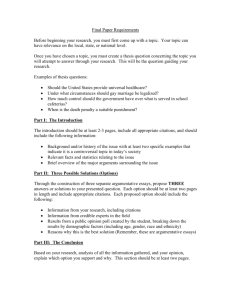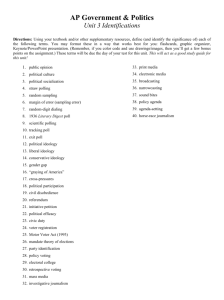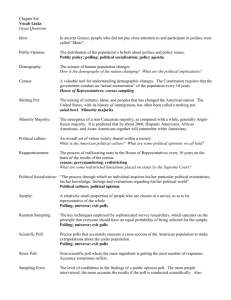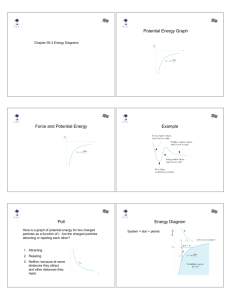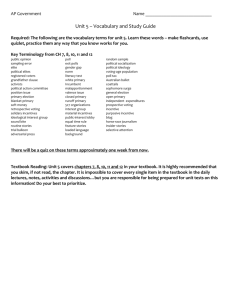here - University of Delaware
advertisement
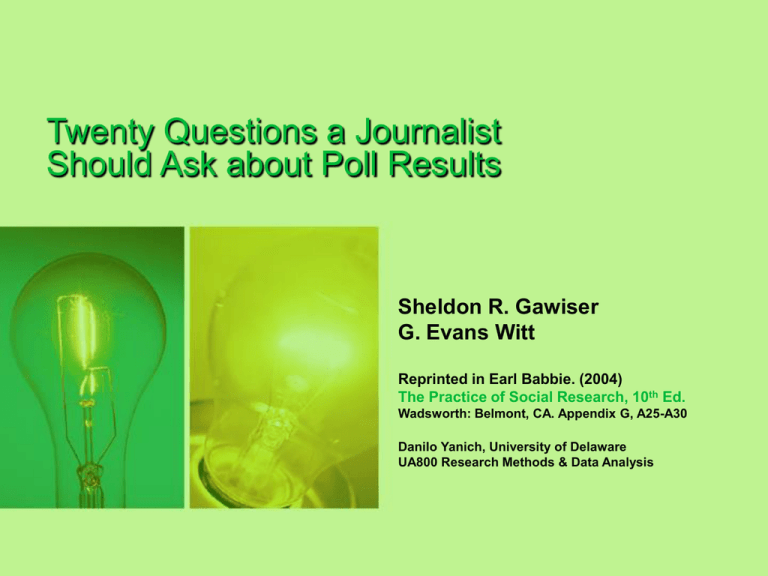
Twenty Questions a Journalist Should Ask about Poll Results Sheldon R. Gawiser G. Evans Witt Reprinted in Earl Babbie. (2004) The Practice of Social Research, 10th Ed. Wadsworth: Belmont, CA. Appendix G, A25-A30 Danilo Yanich, University of Delaware UA800 Research Methods & Data Analysis 1. Who did the poll? • What polling firm, research house, political campaign, corporation, or other group conducted the poll? • If you don't know who did the poll, you can't get the answers to all the other questions listed here. • And if the person providing poll results can't or won't tell you who did it, serious questions must be raised about the reliability of the results being presented. Who paid for the poll and why was it done? 2. • You must know who paid for the survey, because that tells you--and your audience--who thought these topics were important enough to spend money finding out what people think • And that goes to the whole issue of why the poll was done • Polls usually are not conducted for the good of the world – They are conducted for a reason---either to gain helpful information or to advance a particular cause How many people were interviewed for the survey? 3. • Because polls give approximate answers, the more people interviewed in a scientific poll, the smaller the error due to the size of the sample, all other things being equal. • Avoid the common trap that "more is automatically better.” – It is true that the more people interviewed in a reliable survey, the smaller the sampling error--all other things being equal. – But, other factors may be more important in judging the quality of a survey. 4. How were those people chosen? • The key reason that some polls reflect public opinion accurately and other polls are unscientific junk is how the people were chosen to be interviewed. • In scientific polls, the pollster uses a specific method for picking respondents. • In unscientific polls, the person self-selects to participate – Ex: adult entertainment study • The method pollsters use to pick interviewees relies on the bedrock of mathematical reality. What area---or what group---were these people chosen from? 5. • Although the results of probability samples can be projected to represent the larger population from which they were selected, the characteristics of the larger population must be specified • For example, a survey of business people can reflect the opinions of business people, but not of all adults. Are the results based on the answers of all the people interviewed? 6. • One of the easiest ways to misrepresent the results of a poll is to report the answers of only a subgroup. • For example, there is usually a substantial difference between the opinions of Democrats and Republicans on campaign-related matters. – Reporting the opinions of only Democrats in a poll reported to be of all adults would substantially misrepresent the results. Who should have been interviewed and was not? 7. • You ought to know how many people refused to answer the surveyor or were never contacted. • The non-response rate is the percentage of people contacted who should have been interviewed, but were not. • The results of a survey should be judged very differently if the 100 convention delegates interviewed were a random sample of 1000 delegates… – As compared to their being the only 100 out of the 1000 willing to participate. 8. When was the poll done? • Events have a dramatic impact on poll results. – Your interpretation of a poll should depend on when it was conducted relative to key events. – The President may have given a stirring speech to the nation, the stock market may have crashed, or an oil tanker may have sunk, spilling millions of gallons of crude on beautiful beaches. • Poll results that are several weeks or months old may be perfectly valid as history, but are not always newsworthy. 9. How were the interviews conducted? • Three main possibilities: in person, by telephone, or by mail. • Most surveys are now conducted by telephone, with the calls made from a central interviewing center. • Mail surveys can be excellent sources of information, but it takes weeks to do a mail survey, meaning that the results cannot be as timely as a telephone survey. • Surveys done in shopping mails, in stores or restaurants or on the sidewalk may have their uses for their sponsors, but publishing the results in the media is not among them. – These “man in the street” approaches may yield interesting human interest stories, but they should never be treated as if they represent a public opinion poll. Is this a dial-in, a mail-in, or a subscriber coupon poll? 10. • If the poll is a dial-in, mail-in, or coupon poll, don't report the results because the respondents are self- selected. – These pseudo-polls have no validity. • In these pseudo-polls there is no way to project the results to any larger group. – Scientific polls usually show different results than pseudo-polls. 11. What is the sampling error for the poll results? • Interviews with a scientific sample of 1000 adults can accurately reflect the opinions of more than 185 million American adults. • But what happens if another carefully done poll of 1000 adults gives slightly different results? – Neither of the polls is “wrong." – This range of results is called the error due to sampling, often called the margin of error. • This is not an “error" in the sense of making a mistake. • It is a measure of the possible range of approximation in the results because a sample was used. • For example, a “3 percentage point margin of error" in a national poll means that if the attempt were made to interview every adult in the nation with the same questions in the same way at about the same time as the poll was taken… – The poll's answers would fall within plus or minus 3 percentage points of the complete count result 95% of the time. What other kinds of mistakes can skew poll results? 12. • Question phrasing and ordering are also a likely source of flaws • You should always ask if the poll results have been "weighted.“ – Usually used to account for unequal probabilities of selection and to correct demographics in the sample. – However, you should be aware that a poll can also be unduly manipulated by weighing to produce some desired result. • And there are other possible sources of error such as: – Inadequate interviewer training and supervision – Data processing errors, and other operational problems 13. What questions were asked? • You must find out the exact wording of the poll questions. • Why?... because the very wording of questions can make major differences in the results. • Perhaps the best test of any poll question is your reaction to it. – On the face of it, does the question seem fair and unbiased? – Does it present a balanced set of choices? – Would people you know be able to answer the question? National Rifle Association survey* • Sent to local political candidates • Cover letter has the following warning in bold: – Candidates who fail to respond may be rated “?” in mailings to NRA members in the district. – A question mark may be interpreted by our membership as indifference or outright opposition to sportsmen and sportsmenrelated issues. – Please note that any question left blank will be counted against the candidate. – In other words, we’re going to attach responses to your survey whether you answer the questions or not. *Source: Document sent to Delaware political candidates from the National Rifle Association of America Political Victory Fund, Institute for Legislative Action in Fairfax, VA dated 2 Aug 2004. Signed by Jennifer H. Palmer, Delaware State Liaison. NRA survey question “background” ….. hint, hint! • First, the “background” that precedes the specific question that the participant needs to answer “correctly”… – When a gun is fired, markings are left on the bullet and cartridge case. Some argue that these markings can be used to identify a gun used in a crime, and states should require all guns sold to be tested and ballistically “fingerprinted”. – New York and Maryland have each spent millions of dollars creating ballistic “fingerprinting” databases, yet the systems have proven crimesolving failures. – Many have argued that such a program would be nothing more than a waste of tax-payer dollars, as well as a back-door firearm registration scheme. Now the “question” • Would you support legislation that required the collection of the “fingerprint” data for firearms sold in Delaware? – Yes? – No? 14. In what order were the questions asked? • Sometimes the very order of the questions can have an impact on the results. • Often that impact is intentional; sometimes, it is not. – What is important here is whether the questions that went before the important question affect the results. – For example, if the poll asks questions about abortion just before a question about an abortion ballot measure, those previous questions could sway the results. What other polls have been done on this topic? 15. • Do they say the same thing? • If they are different, why are they different? • Results of other polls---a candidate's opponent, public polls, media polls, etc.---should be used to check and contrast poll results you have in hand. – If the polls differ, first check the timing of when the interviewing was done – May demonstrate a swing in public opinion. 16. So, the poll says the race is all over. What now? • No matter how good the poll, no matter how wide the margin, no matter how big the sample… • A pre-election poll does not show that one candidate has the race "locked up." • Things change---often and dramatically in politics. 17. Was the poll part of a fund-raising effort? • Another example of a pseudo-poll… • An organization sends out a survey form to a large list of people. • The last question usually asks for a contribution from the respondent. • The people who respond to these types of surveys are likely to be those who agree with the organization's goals. – Also, the questions are usually loaded and the results meaningless. – This technique is used by a wide variety of organizations from political parties and special-interest groups to charitable organizations. – If the poll in question is part of a fund-raising pitch, pitch it in the waste basket. National Park and Conservation Association National Survey: A Sham • First, a checkbox BEFORE the questions that says: – Please send me information about other ways I can get involved in NPCA park protection programs to help safeguard our cherished national parks for future generations. • And at the end: – YES, I’ll gladly do my share to help protect America’s national parks. Please enroll me as a conservator as well as a user of America’s most beautiful wild lands and most meaningful historic heritage. I have enclosed my membership contribution of: $100, $50, $25, $20, $15, other. ($25 is circled by the NPCA…hint, hint) • Followed by, in CAPITAL LETTERS AND LARGE FONT – YOUR GIFT AT THIS LEVEL WILL REALLY HELP! NPCA National Sham Survey: A representative question • First the setup – There is widespread agreement that restoring conditions in Florida’s Everglades National Park is a priority, but finding the money to pay for it has been difficult. • Now the indictment – One option is a tax on Florida’s sugar cane industry, which is a major source of pollution in the park. • Finally the pseudo question – Would you be willing to spend 5 cents more for a bag of sugar if you knew the money would help restore the Everglades’ natural environment? Yes__No__ 18. So I've asked all the questions. The answers sound good. The poll is correct, right? • Usually, yes. • However, remember that the laws of chance alone say that the results of one poll out of 20 (remember the 95% confidence level) may be skewed away from the public's real views just because of sampling error. 19. With all these potential problems, should we ever report poll results? • Yes, because reputable polling organizations consistently do good work. • In spite of the difficulties, the public opinion survey, correctly conducted, is still the best objective measure of the state of the views of the public. 20. Is the poll worth reporting? • If the poll was conducted correctly… • And you have been able to obtain the information outlined here… • Your news judgment and that of your editors should be applied to polls, as it is to every other element of the story.

